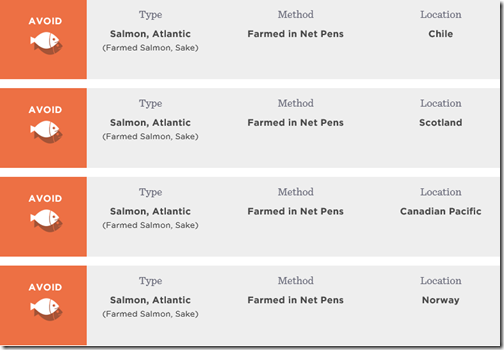Seriously, I am not trying to wreck the Norwegian seafood industry with articles about whale kills and farmed salmon. When I travel I observe and learn. Today I checked to see if the large pens off the coast of Norway I observed from the Norwegian Air flight from Oslo Torp (TRF) to Bergen were actually Atlantic salmon farms. They are.
Click this link to see an image of a Norway coast Atlantic salmon farm similar to what I saw from the plane.
What I did not know until this morning is Monterey Bay Aquarium’s SeafoodWatch.org published several 2014 research reports with the conclusion that Norwegian farmed Atlantic Salmon is on their ‘Avoid’ list. Being from California, I normally buy fresh wild caught Pacific salmon, so I was unaware until today that there are several reasons why Norwegian farmed Atlantic salmon is on the ‘avoid’ list.
Since I have been eating farmed Norwegian Atlantic salmon for the past ten days at every Nordic Choice Hotels complimentary breakfast, I’ll share what I learned are considered the problems with farmed Atlantic salmon.
Why Norwegian farmed Atlantic Salmon makes SeafoodWatch.org ‘Avoid’ list.
Norway is the world’s largest producer of farmed Atlantic salmon with 366 million fish produced in about 1,000 large ocean pens off the coast. Norway has the largest population of wild Atlantic salmon, yet the number of farmed salmon is 250 to 700 times more than wild salmon. Farmed salmon require a diet rich in fish oil. Norway uses 25% of the world’s fish oil in salmon feed.
There are three criteria where farmed salmon falls short in its environmental impact.
1. Chemicals – More than 6.5 million metric tons of pesticides are used in Norwegian Atlantic salmon farming, primarily to control sea lice. The use of pesticides has risen rapidly in the past few years due to ineffectiveness as sea lice become more resistant to treatments, thus requiring multiple treatments.
There is concern over the amount of antibiotics used in salmon farming potentially reducing the usefulness of these antibiotics for human medical purposes. The use of antibiotics is considered low in Norway, however, there was a 300% increase in the total amount of antibiotics used between 2011 and 2012 and 88% of these antibiotics are also used for human treatment.
2. Disease – the farmed population of Atlantic salmon vastly outnumbers wild salmon. Disease among farmed salmon is a great concern for its potential impact on wild salmon and sea trout.
3. Escape – genetically different farmed salmon mixing with wild salmon populations has been documented. In 2011, there were an estimated 300,000 farmed salmon escaped from Norway’s pens. The Hardangerfjord is Norway’s largest fjord and a major tourist attraction for visitors to Bergen. Farmed salmon outnumber wild salmon 5000 to 1 in Hardangerfjord. In some years the number of escaped salmon from pens outnumbers the wild salmon population.
Open net pen farmed Atlantic salmon from Norway receive an “Avoid” due to high concerns regarding the use of chemicals, the impacts of escapes on wild salmon and sea trout, and the transfer of parasites to wild populations.
Source: Seafoodwatch.org – Farmed Atlantic Salmon in Norway
Kind of amazing what is inadvertently learned from travel and food choices. It would be nice if I could just relax on a trip and focus on the hotels and tourist board information, but I can’t. When I go to the Caribbean, I am struck by racism. When I go to Thailand I am abhorred by the sex tourism. In Norway, a beautiful country of fjords and forests, it is the minke whale meat and farmed Atlantic salmon issues I have come to face on this trip.



11 Comments
Comments are closed.